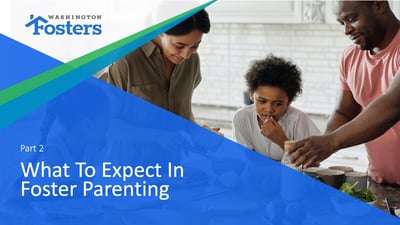Years ago, foster parent Katie Biron took in a newborn baby. Around the time the child was a year old, in-person visits aimed at supporting reunification were resumed with the parent. But the visits were difficult for everyone involved.
Biron had become a trusted adult in the child’s life by taking on the role of primary caregiver. Being picked up from Biron by someone the child didn’t know (the visit supervisor), placed into that stranger’s vehicle and taken to a strange room to interact with a parent they had been separated from for months was confusing and scary for this young child.
Access Our FREE On-Demand Webinar Course: Foster Parenting in Washington State
Children depend on the trusted adults in their lives to help ease the transition into a new situation. When forced into abrupt transitions with unfamiliar people and in an unfamiliar setting, the child’s sense of stability is shaken, and the experience is nothing less than traumatizing.

Every child who enters foster care has experienced the trauma of being separated from their parents, from their homes, from familiarity. But that trauma often doesn’t stop when they enter out-of-home care, especially when they’re unable to find a sense of stability.
Why Foster Children Need Stability
According to Dr. Gregory L. Jantz, a depression specialist and psychologist, “One of the deepest needs of children is for consistency, including the knowledge that they are unconditionally accepted and valued by those who love them.”
The relationship between stability and trauma is well known in the foster care world. Instability has been shown to have a profound impact on a child’s emotional, psychological, and development well-being.
Imagine how scared a child is when they come into a new home. Their room is different, the people caring for them are strangers, and they might have no idea where their parents are.
When children are placed in unpredictable, unfamiliar environments, it also often leads to behavioral issues and poorer educational outcomes. For example, imagine how hard it would be to focus in school if you had been separated from your parents, switched schools, and now lived with complete strangers.

When foster children are supported, they’re able to find room to heal, to build trusting relationships, to count on people, and to focus on other things like school, friends, or just being kids.
Stability isn’t just about foster children either, it’s about their parents, who are likely experiencing their own trauma being separated from their child. When foster parents can add stability for birth parents, it makes things easier on children and aids in reunification.
How Foster Parents Can Build Stable Environments
“You have to remember, you're not caring for this child in isolation. You're actually caring for someone else's child as part of a team.” — Katie Biron, foster parent
Stable environments are ones that rely on routines, predictability, and safety, all things any parent would want for their child. But foster parents have the added challenge of creating stability for a child who has experienced trauma.
 1. Be Open to Partnership
1. Be Open to Partnership
When a child enters foster care, a lot of new people are brought into their life. Caseworkers, social workers, foster parents, and lawyers are suddenly involved with the decisions that govern their day-to-day lives. Foster parents who resist these partnerships only add to a child’s instability and trauma.
“I try to tell people to think about these partnerships like an in-law relationship. You don't pick your in-laws, but because you mutually care about the same person, you have to figure out how to have a partnership or a relationship with them,” says Biron. “The more everybody can be on the same team, the more we can build a network of support and consistency around the child and the more stable a child will be.”
 2. Use A Trauma-Based Lens
2. Use A Trauma-Based Lens
As discussed above, every child in foster care experiences trauma, even newborns who are torn from the familiarity of their mother’s smell, her voice, her sounds. Children begin forming an attachment to their parents well before birth, so foster parents must accept this baseline trauma and adjust their perspective to match.
When outward behaviors are challenging, the root cause is often much deeper than the surface problem. For example, a child who throws a tantrum because they don’t like what’s for dinner may be lashing out because it reminds them of meals they shared with their parents.
Biron also suggests using a trauma-based lens for the child’s parents, who might be defensive because they feel ashamed, or may use you as an outlet for the frustration they're feeling with the system. Offering empathy instead of judgement will reap rewards for you as a foster parent, and for the families you support.
 3. Supporting Love For Both Families
3. Supporting Love For Both Families
Reunification is the primary goal for all children and their parents. The true gift of fostering comes when foster parents are able to help parents and children reunite as families. Supporting reunification is also one of the most difficult things foster parents will ever do, and it starts by giving a child space to love everyone in their life.
“It’s about bridging the gap and showing the child that it's okay to love their parents and their foster parents. A child can never have too many people that love them.” says Biron.
Hanging pictures of a child’s family in your home, talking positively and regularly about their parents, or helping them pick out gifts for their family on holidays are all great examples of ways foster parents support the child’s love for two families. Building relationships with the child’s parents allows for consistency in routines, rules, comfort items, and easier transitions for the child. As Biron says,
“Everything about foster care is confusing. And there's a lot of it that just plain sucks, but everyone working together to support the child helps so much.”
Foster parents who exemplify Biron’s attitude are well on their way to creating a stable, happy, healthy environment for any child that they welcome into their home
Thinking about becoming a foster parent? Click here to access our FREE on-demand 8-part webinar course to learn more about the importance of foster parents, the process of getting licensed, and the everyday experience of caring for a foster child..








